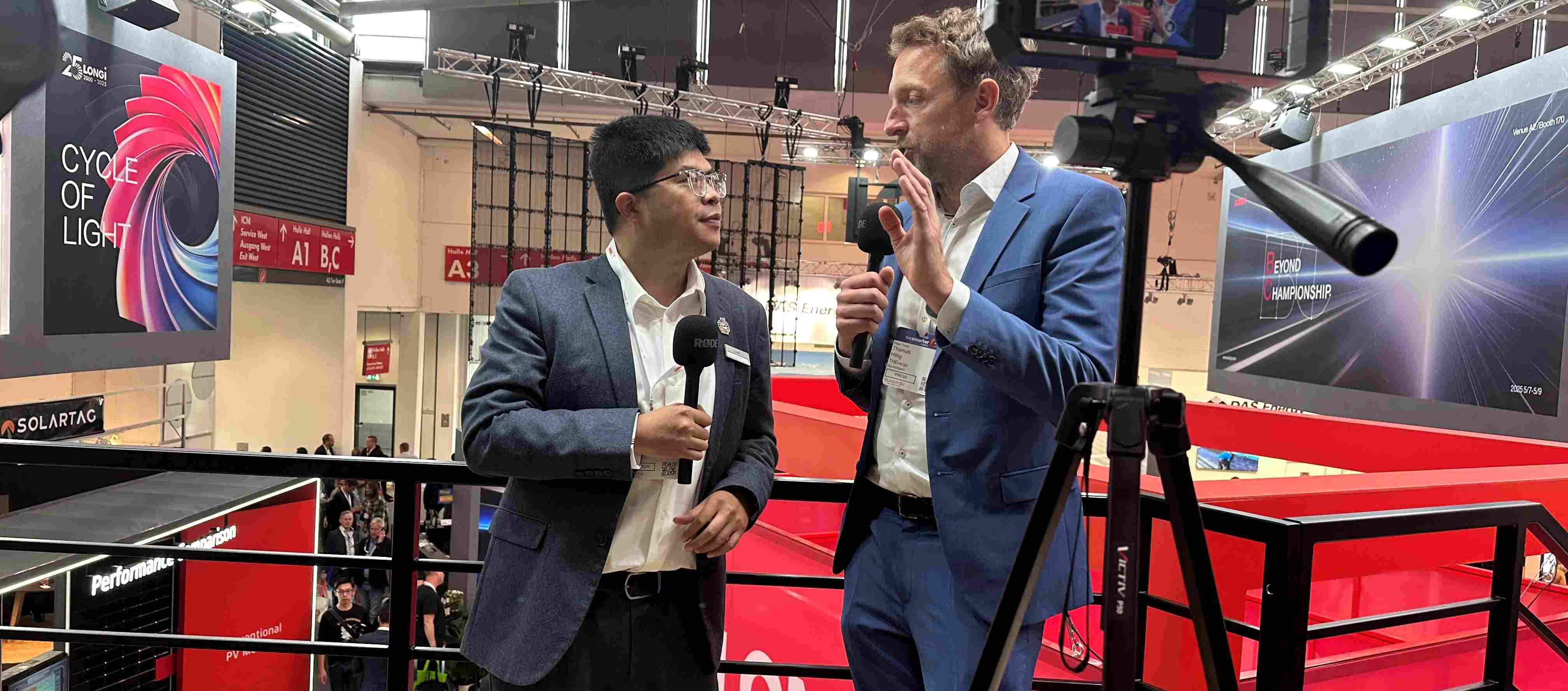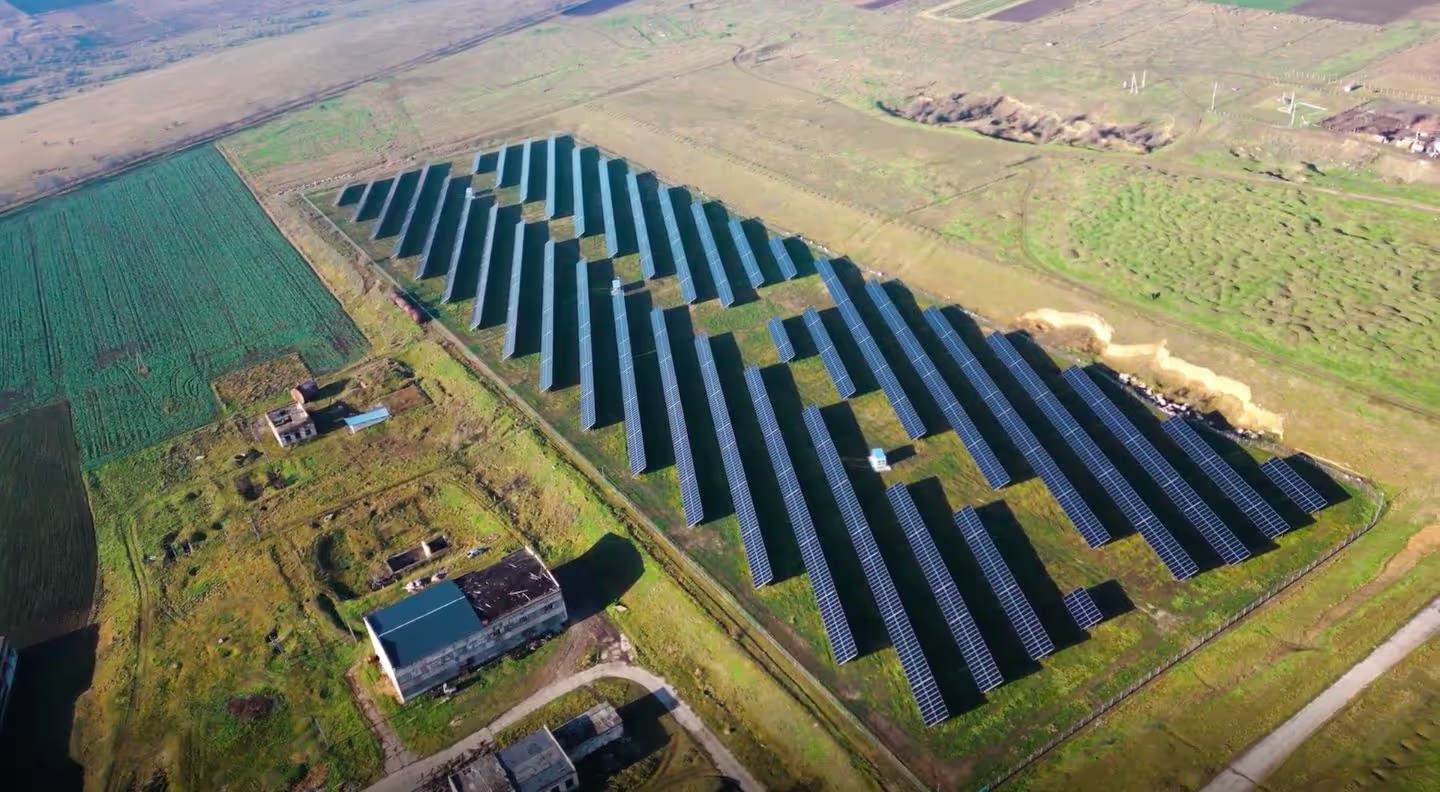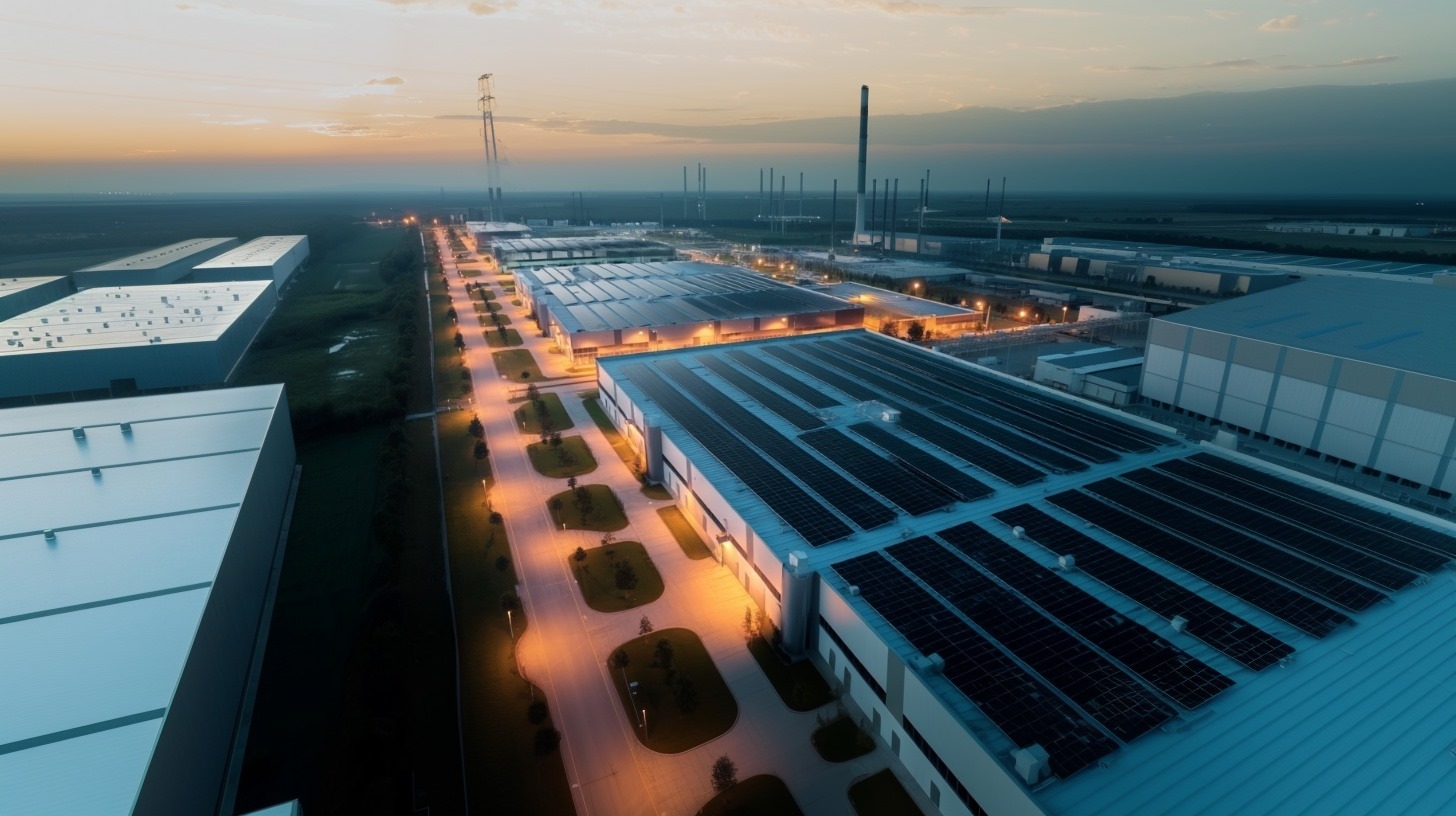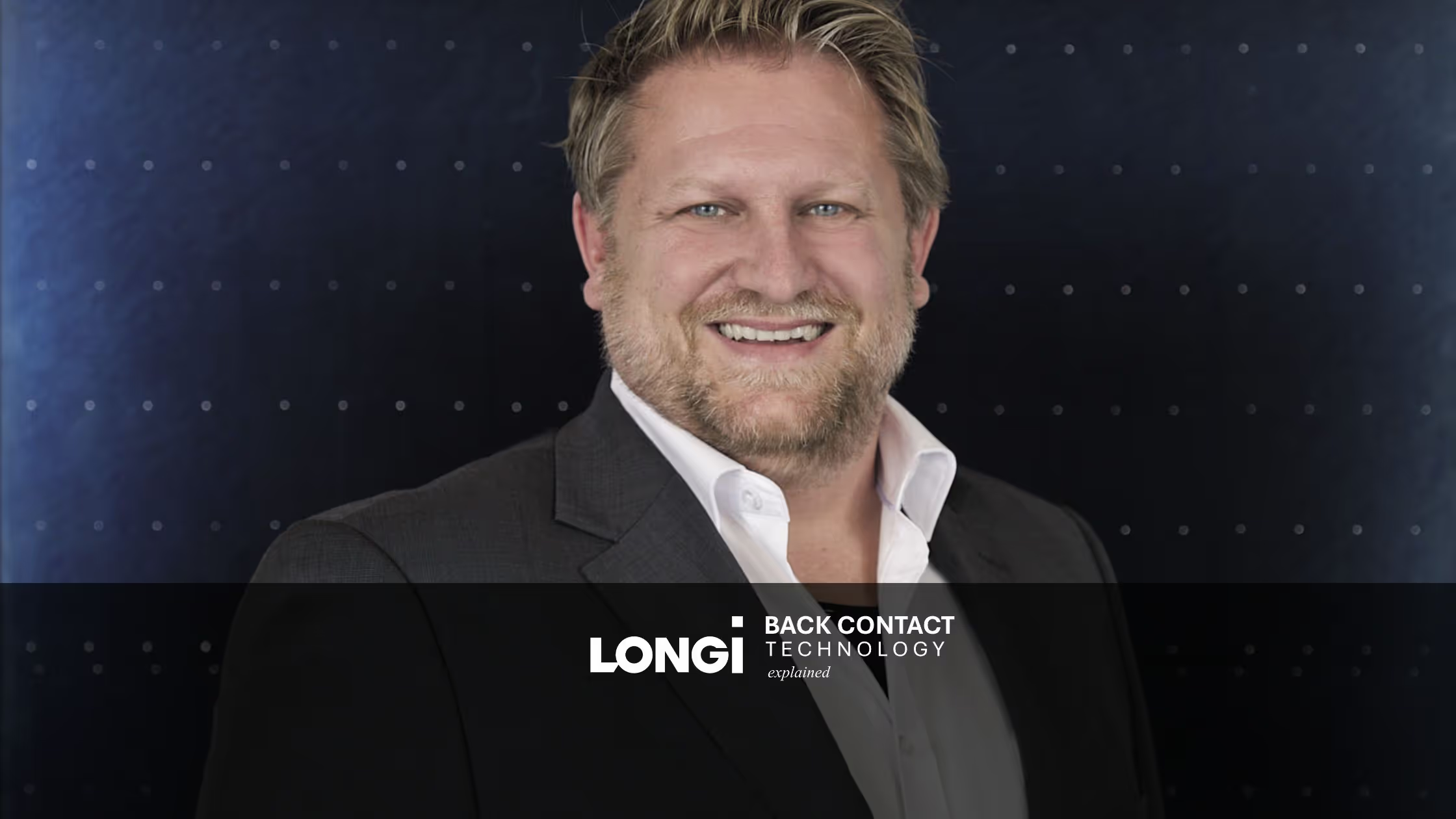Technologie s kontakty na zadní straně: Jak HPBC 2.0 od LONGi zlepšuje výkon ve částečném stínu
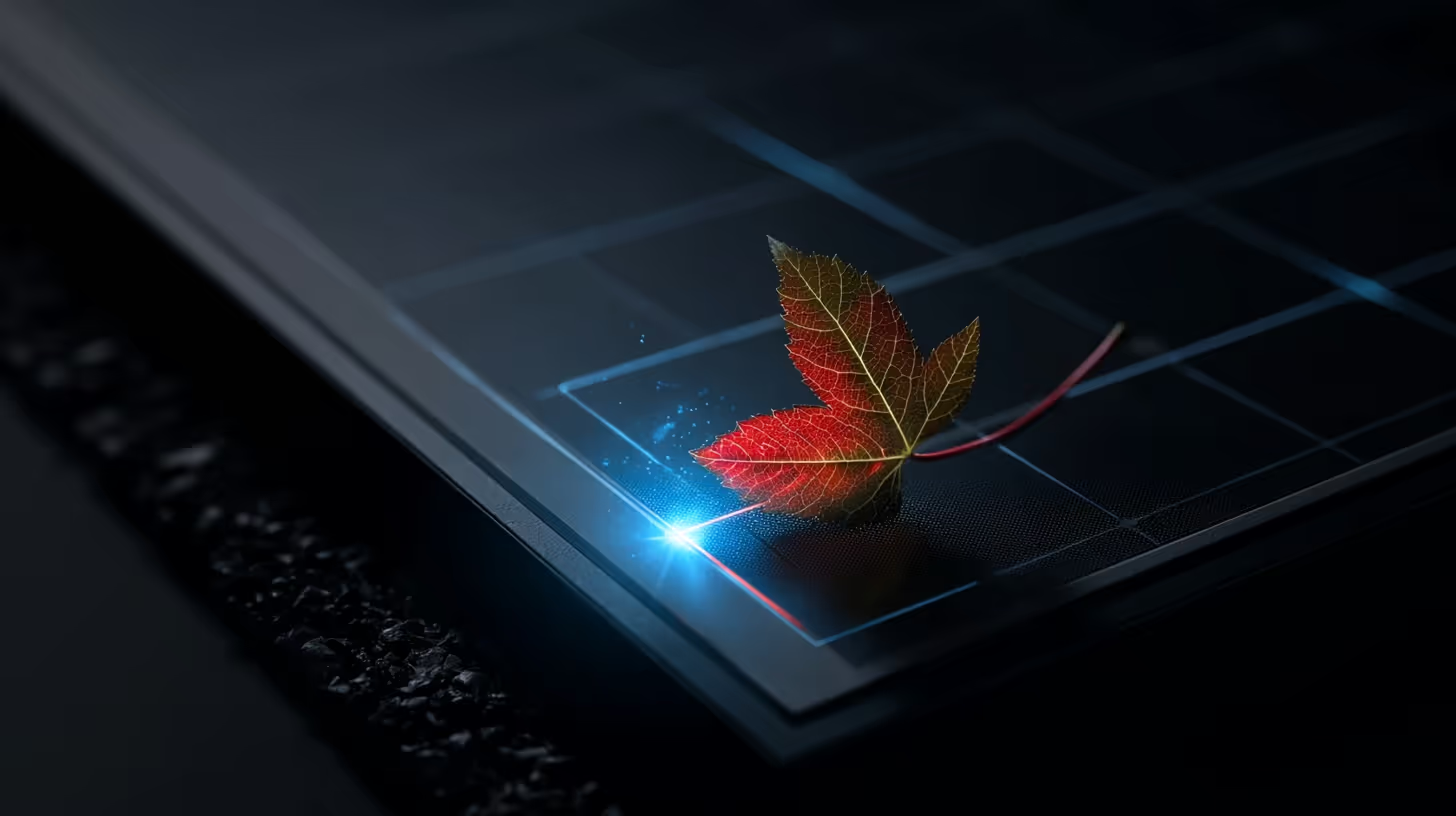
Datum
06.10.2025
Doba čtení
5
minuty
Přihlaste se k odběru newsletteru LONGi
Každý, kdo žije se solární energií, zná tu frustraci: malé stínění od stromu nebo komínu může způsobit neúměrný pokles výkonu. Tradiční solární panely jsou na stínění velmi citlivé. I když je obsažen jen malý kousek povrchu, ztráty výstupu 15–25 % jsou běžné. V závažnějších případech studie a terénní testy uvádějí ztráty 30–40 %, a v extrémních situacích - když je ve stringu stíněna jediná buňka - celé moduly mohou ztratit více než polovinu svého výkonu. Tento široký rozsah ukazuje, proč stínění patří k jednom z nejkritičtějších rizik výkonu v konvenčním návrhu solárních systémů.
Hybridní pasivovaný kontakt na zadní straně (HPBC) od LONGi představuje významný krok vpřed v designu solárních článků. Poprvé byl uveden v listopadu 2022 s řadou Hi-MO 6 a vylepšen v roce 2024 s Hi-MO X10, HPBC přesouvá veškeré elektrické kontakty na zadní stranu článku. Tato architektura maximalizuje vstřebávání světla na přední ploše a umožňuje proud proudit po více cestách, čímž snižuje dopad výkonu při částečném stínění. S HPBC 2.0 šel LONGi ještě dále tím, že zavedl vestavěný optimalizátor stínění. Tato funkce inteligentně přesměrovává proud kolem stíněných oblastí, například od listu či větve, čímž zajišťuje, že modul udrží vyšší výstup i za neideálních podmínek.
Pro majitele domů a podniky to znamená vyšší výnosy tam, kde částečné stínění bylo vždy omezujícím faktorem.
Co je technologie HPBC 2.0?
HPBC znamená Hybridní pasivovaný kontakt na zadní straně, architekturu solárních článků, kterou vyvinul LONGi. Návrh spojuje pokročilé pasivace s kompletním uspořádáním kontaktů na zadní straně, čímž zůstává přední plocha bez kovových mřížek. Absence metalizace na přední straně zlepšuje estetiku, ale ještě důležitější je, že umožňuje článku zachytit více fotonů. Výsledkem je vyšší konverze účinnosti a zcela odlišný způsob řízení toku proudu, který snižuje dopad stínu na výkon.
Technologie HPBC 2.0 od LONGi dosáhla světového rekordu účinnosti modulu 25,4 %, nezávisle ověřeno Fraunhofer ISE v laboratorních podmínkách. Tato hodnota ukazuje skutečný potenciál technologie. Řada Hi-MO X10, postavená na stejné platformě HPBC 2.0, dosahuje komerčních účinností modulů až 24,8 % a výkonů až 670 W.
Díky optimalizovanému řízení proudu a vestavěné kontrole stínění může HPBC 2.0 snížit ztráty výkonu ze částečného stínění až o 70 % ve srovnání s konvenčními technologiemi modulů, čímž zajišťuje stabilní výrobu energie i v náročných podmínkách na střeše.
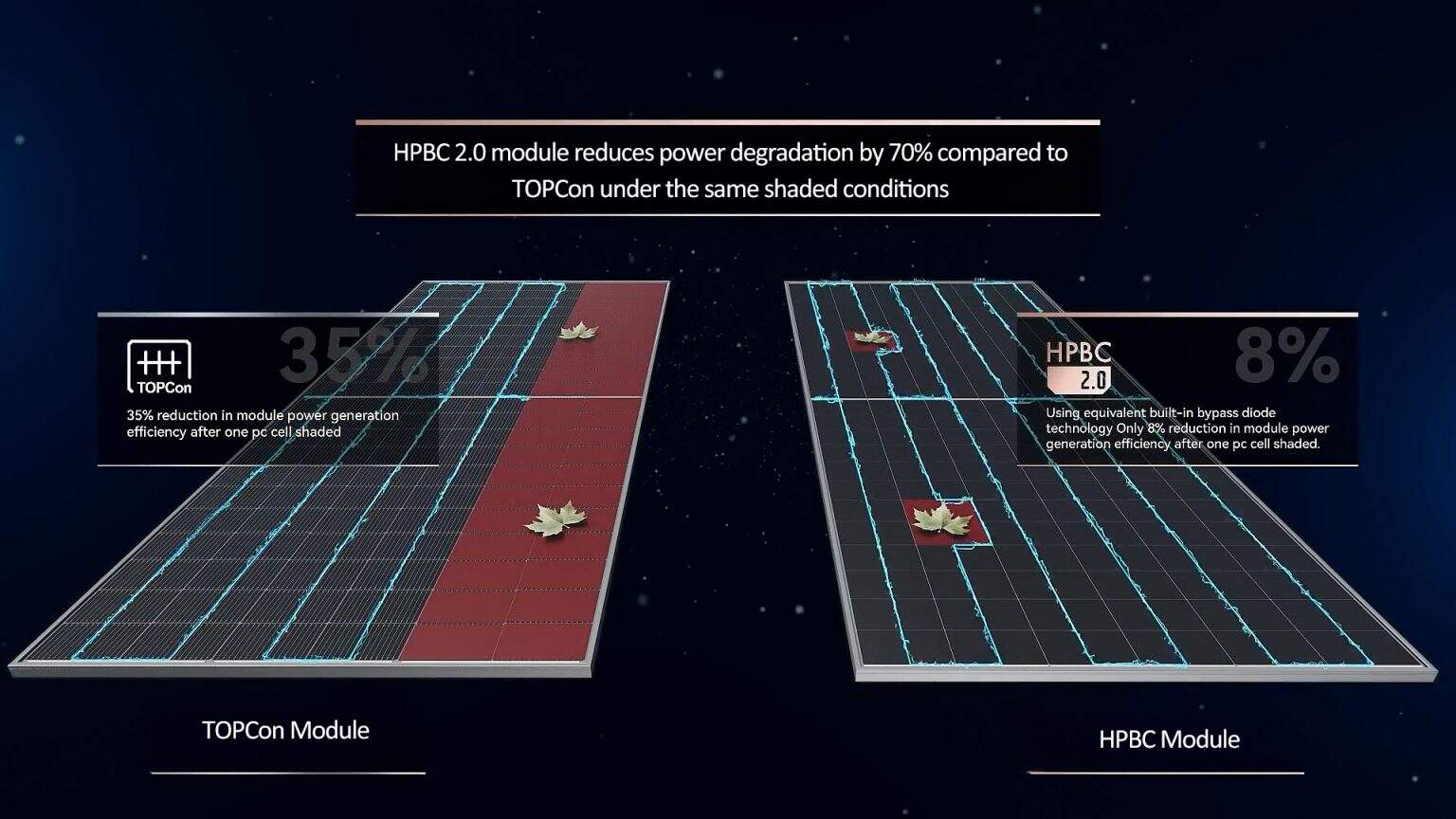
Proč konvenční panely špatně zvládají stínění
Konvenční PERC a TOPCon moduly spojují buňky do série, podobně jako řetěz světel. Když je část buňky stíněná, zvyšuje se odpor pro celý řetězec, snižuje výstup. I lehké stínění 5 % povrchu modulu může způsobit ztrátu 15–25 % nebo více.
Tato strukturální slabina vždy omezovala výkon solárních systémů v prostředích, kde komíny, stromy nebo blízké budovy vrhají nepravidelné stíny.
Zpět-kontakt design: Jak HPBC 2.0 zvládá stínění jinak
V buňkách HPBC 2.0 jsou kladné i záporné kontakty umístěny na zadní straně v prokládaném vzoru. To uvolňuje celou přední stranu pro absorpci světla a snižuje optické stínění.
Místo toho, aby proud byl nucen procházet jednou cestou, zadní design HPBC umožňuje elektřině obejít stíněné oblasti tím, že teče alternativními cestami. To je srovnatelné s přesměrováním dopravy kolem uzavřené silnice.
Společně tyto prvky zajišťují stabilnější výstup výkonu. Podle testů Čínského národního centra pro kontrolu kvality fotovoltaiky (CPVT) ukázaly moduly LONGi HPBC 2.0 denní nárůsty přesahující 10 % ve srovnání s konvenčními moduly v dynamickém stínění.
Ve skutečných projektech zákazníci hlásí významná zlepšení. Instalace vystavená stínu od stromů zaznamenala nárůst výroby téměř o 18 % po přechodu na moduly HPBC, s největšími výhodami v pozdním odpoledni, kdy stíny dříve způsobovaly vážné ztráty.
Porovnání HPBC 2.0, TOPCon a PERC
Solární trh dnes v zásadě nabízí tři klíčové technologie. Zde je, jak HPBC 2.0 od LONGi funguje ve srovnání s TOPCon a PERC.
.png)
Vysvětlení technologických charakteristik
LONGi’ back contact technology HPBC 2.0
HPBC 2.0 představuje další evoluci LONGiho technologie s kontaktem na zadní straně. Na základě první generace Hi-MO 6, uvedené v roce 2022, a Hi-MO X10 z roku 2024, která kombinuje čisté přední plochy bez mřížek s integrovaným uspořádáním pro optimalizaci stínění, tato inovace nejen zvyšuje účinnost na rekordní úrovně 26,6 % na článku a 24,8 % na modulu, ale také zajišťuje stabilnější výkon, když jsou části panelu stíněny. S vyšší výchozí účinností a vylepšenou odolností v reálném světě je HPBC 2.0 zvláště atraktivní pro střechy, fasády, projekty C&I a pro elektrárny s velkou kapacitou, kde hustota energie a spolehlivost přímo ovlivňují návratnost investic.
Zde je shrnutí klíčových vlastností:
Stínění nepřítomné na přední straně: Přesunem obou elektrických kontaktů na zadní stranu buňky je přední plocha zcela bez překážek, což umožňuje co největší průchod světla na vrstvu, která světlo pohlcuje.
Vylepšené pohlcování světla: Vícevrstvá antireflexní vrstva a zlepšená uniformita mikrotextury snižují odraz krátkovlnného světla, zachycují více slunečního světla a zvyšují proud při zkratu.
Vynikající výkon při vysokých teplotách: Technologie má koeficient tepelného výkonu -0,26 %/°C, což je o 0,03 %/°C lepší než u TOPCon modulů, čímž zajišťuje lepší výkon v horkých klimátech. Vylepšená odolnost: Moduly HPBC 2.0 vykazují vyšší odolnost vůči UV‑indukované degradaci, vlhkému teplotnímu namáhání a tepelným cyklům ve srovnání s předchozími technologiemi. Tato technologie byla dlouho spolehlivou páteří solárního průmyslu. Ve srovnání s konvenčními buňkami Al-BSF PERC přidává dielektrickou pasivaci a lokálně otevřené zadní kontakty, což snižuje rekombinaci a vrací nevyužité fotony zpět do buňky. Toto zlepšení často vede k nárůstu účinnosti o 1–2 procentní body v praktických kvalitních implementacích. Dnes komerční moduly PERC obvykle dosahují přibližně 20–21,5 % účinnosti. Jak průmysl postupuje, mnoho odborníků věří, že praktický strop PERC se přibližuje a architektura čelí inherentním zranitelnostem jako světlem vyvolaná degradace – zejména u p‑dopovaných formulací. Výsledkem je, že mnoho výrobců směřuje k n-type a alternativám s kontakty na zadní straně, jako jsou TOPCon a technologie s kontaktem na zadní straně, které slibují vyšší potenciál účinnosti a větší odolnost vůči degradaci. Navazuje na PERC tím, že na zadní straně přidává tenkou vrstvu tunelového oxidu a dopovaný polysiliconový film. Tato konfigurace snižuje ztráty rekombinace a podporuje vyšší napětí při otevřeném obvodu. U komerčních modulů TOPCon běžně dosahuje účinnosti kolem 22–23 %, pokročilé návrhy článků posouvají na 24–25 %. Protože výrobní kroky jsou z velké části kompatibilní s výrobními linkami PERC, TOPCon představuje atraktivní cestu pro stávající továrny. Budoucnost technologie s kontakty na zadní straně je široce považována za jednu z nejperspektivnějších oblastí solárního vývoje. Experti jako Radovan Kopeček z ISC Konstanz předpovídají, že výroba BC buněk a modulů by mohla do roku 2030 dosáhnout globální kapacity 1 TW, označovanou za "poslední evoluční krok pro křemíkové krystalické** silicon". Podle Kopečka vypršení klíčových BC patentů kolem roku 2028 urychlí tržní adopci a sníží bariéry pro vstup dalších výrobců. TÜV Rheinland a další certifikační instituce zdůrazňují architektonické výhody BC – čistý, neomezený přední povrch a vyšší konverzní potenciál – jako důvody, proč je BC dobře připravena stát se dalším hlavním PV symbolem. Výhled je podpořen průmyslovými roadmappy: Mezinárodní technologická roadmapa pro fotovoltaiku (ITRPV) vidí návrhy BC získávat stále větší podíl nových instalací až do konce 20s let, s zvláště silnými vyhlídkami pro střechy, fasády a distribuovanou generaci. Se skutečnými výhodami ve stínu, dlouhodobou spolehlivostí a rekordními milníky účinnosti je BC stále považována ne za okrajovou, ale za základní technologii, která definuje další fázi solárního růstu. V čele LONGi vidí technologii s kontakty na zadní straně jako středobod budoucnosti odvětví. “V příštích pěti až šesti letech budou buňky s kontakty na zadní straně hlavním proudem křemíkové technologie,” uvedl v roce 2023 předseda LONGi Zhong Baoshen. Při rozhodování, zda HPBC 2.0 a související řada Hi-MO X10 vyhovují vašemu projektu, zvažte tyto faktory: Přehodnocením toho, jak buňky zachycují světlo a vedou elektřinu, HPBC 2.0 řeší jednu z dlouhodobě nejtrvalejších slabin solárního průmyslu: citlivost na stínění. Tato inovace také otevřela cestu k technologii s kontakty na zadní straně i mimo prémiové střechy a rozšířila její výhody na širší spektrum aplikací. Díky vyšší konverzní účinnosti, lepší toleranci vůči stínu, prokázané odolnosti proti sněhu, krupám a silnému větru a stabilnímu dlouhodobému výstupu je HPBC 2.0 atraktivní volbou pro všechny – bydlení, komerční, průmyslové i elektrárenské projekty. Pro zákazníky C&I BC dodává rychlejší ROI díky vyšším výnosům na čtvereční metr, zatímco ve velkých provozech zvyšuje efektivitu využití půdy, snižuje náklady BOS a maximalizuje výrobu energie po celou životnost projektu. Jak se výroba rozšiřuje a náklady klesají, BC se stává přední technologií napříč hlavními trhy. Pro majitele domů a podniky se stíněním, prioritami výkonu či designu, HPBC 2.0 nabízí způsob, jak zajistit vyšší výnosy, vyšší spolehlivost a elegantní vzhled – což z něj činí jednu z nejvíce budoucnost připravených solárních technologií dostupných dnes. Zjistěte více o naší Řadě Hi-MO X10 jako součást EcoLife Series zde.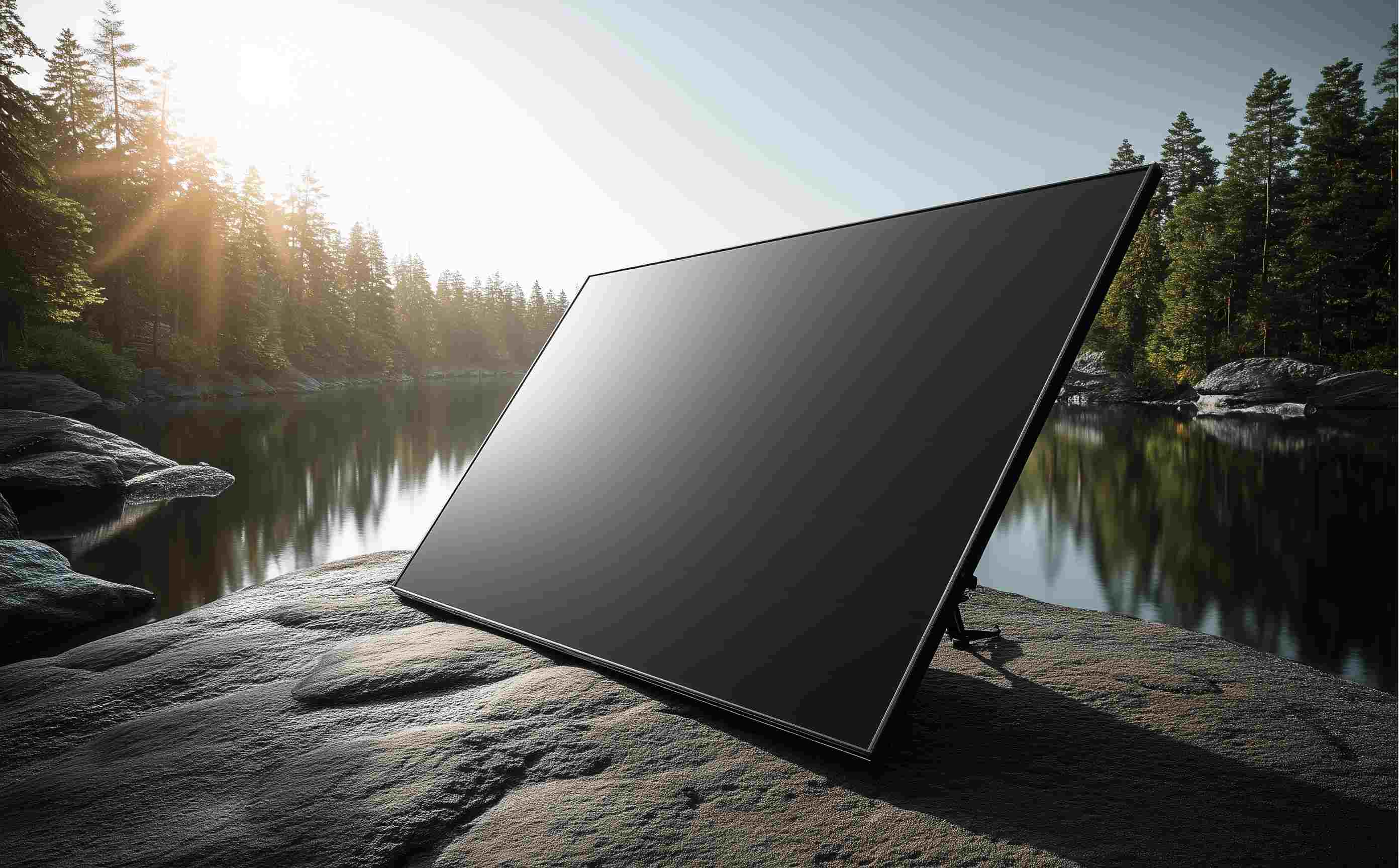
PERC (Pasivovaný emitér a zadní buňka)
TOPCon (Tunelový oxid pasivovaný kontakt)
Budoucnost technologie s kontakty na zadní straně
Je HPBC 2.0 od LONGi ta správná volba pro vás?
HPBC 2.0 je volba pro náročné podmínky – v prémiovém segmentu a dále


.avif)
